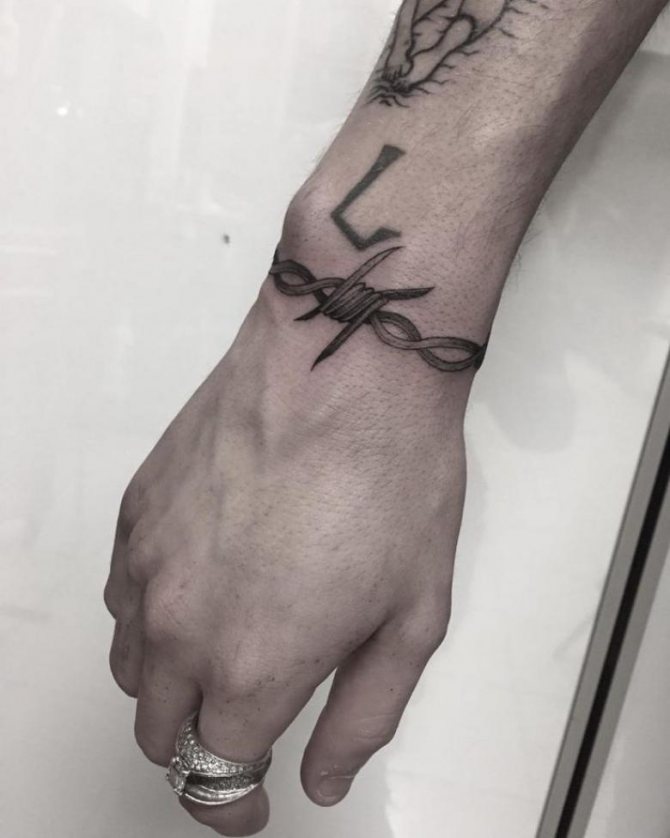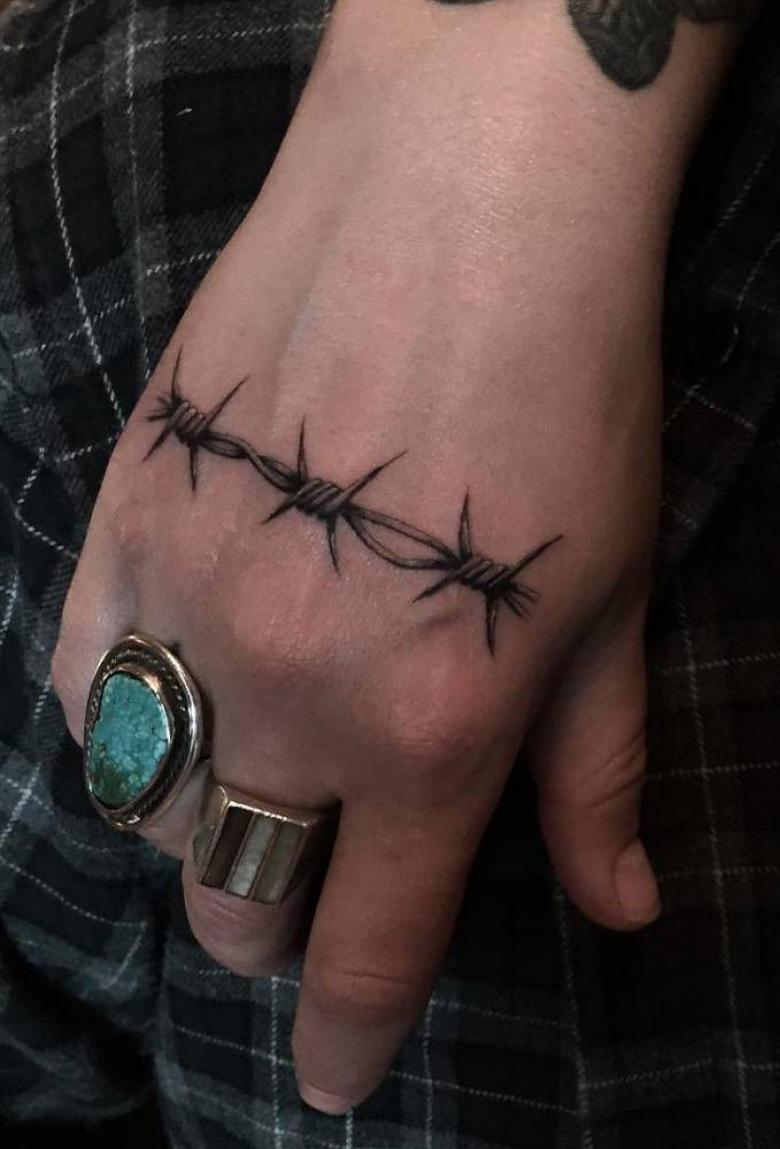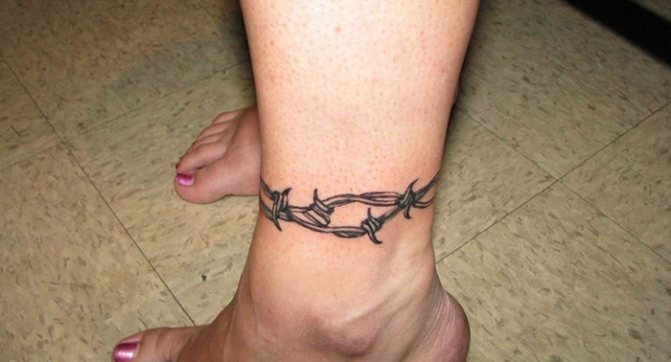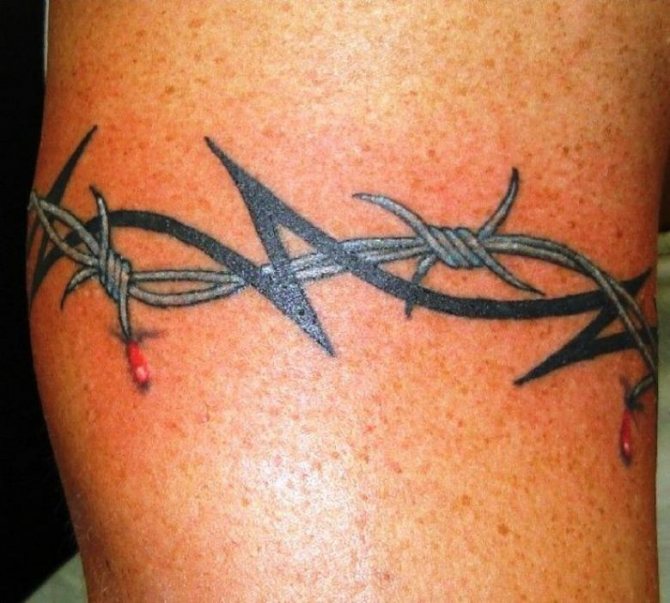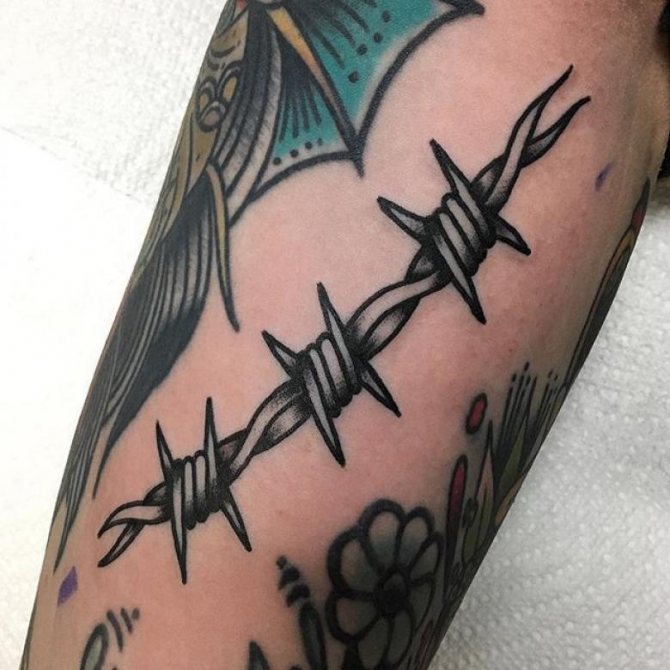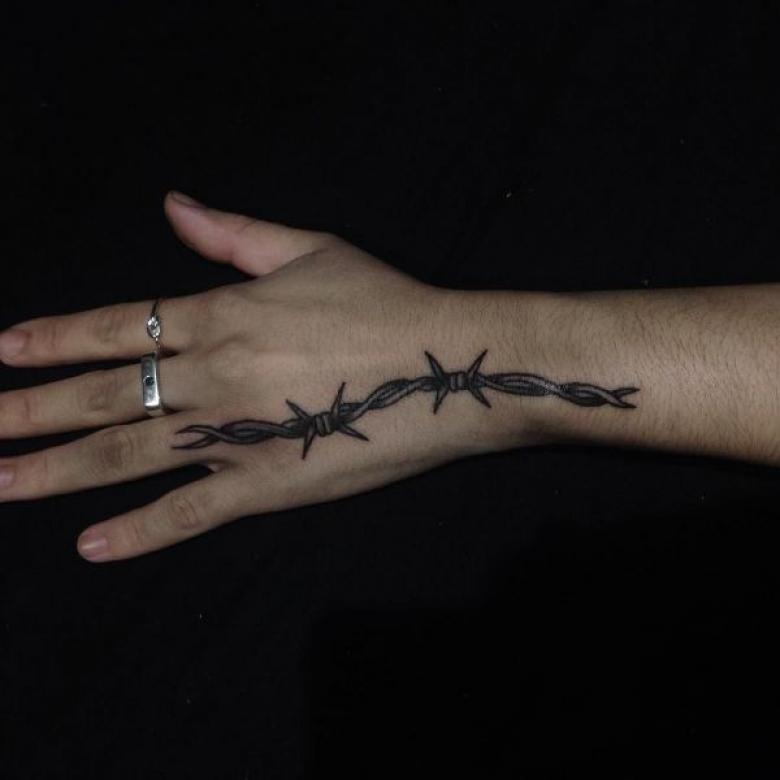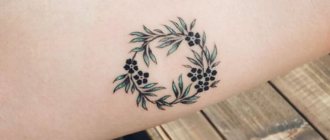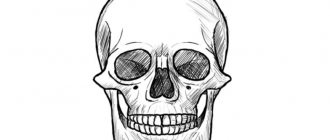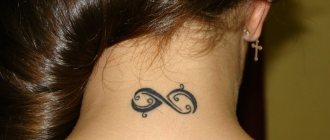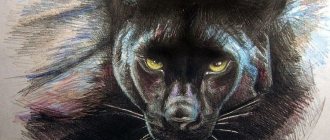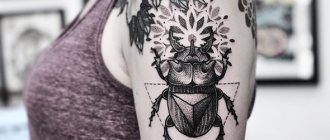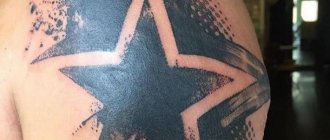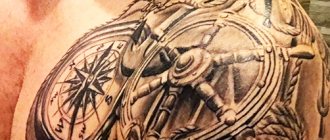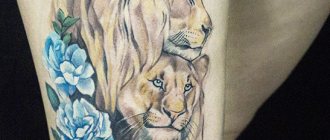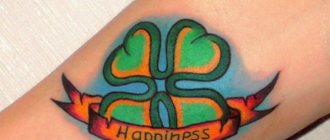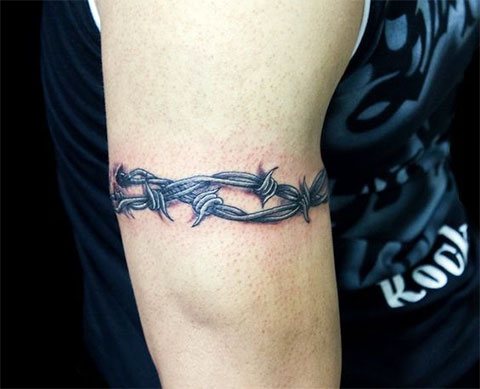
Barbed Wire Tattoo
Barbed wire tattoo Refers to the prison tattoo. Prisoners who have been in prison for several years usually have this design on their arms, shoulders, neck, leg, or wrist. If the person was convicted unjustly, or for lack of sufficient evidence of noninvolvement in the crime, the wire is depicted against the background of the cross, which symbolizes justice. Also, the cross in this sketch can mean "God sees everything".
Features and Benefits
The barbed wire is a fairly common symbol of body jewelry. This sign can play the role of decorating a person (both men and women) or carry a certain semantic load. At the first glance at such symbols, associations immediately arise related to restrictions and prohibitions. In the old days, such wires were tied around the top of the fence so that outsiders could not enter the territory, or vice versa - did not leave it.
Due to the huge spread of informal movements, the barbed wire tattoo has become very popular among young people (including girls). Not so long ago, such symbols were applied to the body of people who are fond of such trends as gothic or rock music. Over time, such trends have slowly receded into the background, but the wire was one of the most popular symbols in the tattoo studios.
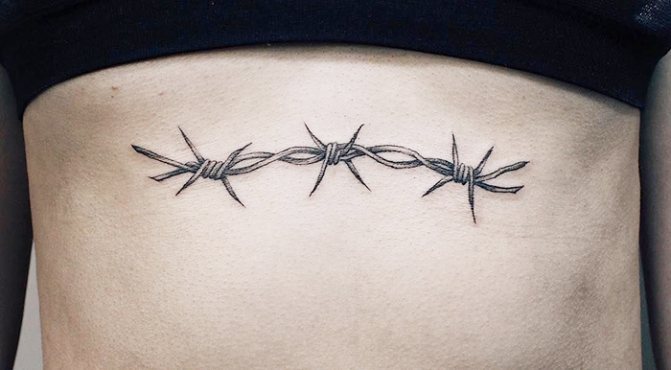

The barbed wire tattoo was originally created in the criminal world. With this design, prisoners were able to count the time they spent in prison. One barbed wire spike was equal to one year of imprisonment. Such a tattoo was a secret sign of cons. After release, the so-called "bratva" could recognize their representatives.
Nowadays, the tattoo is not used to prevent escapes, and the wire itself has ceased to conceal its criminal nature.
Today, such a tattoo is applied to themselves by people who have reached the age of majority. With this symbol they This symbol shows that they broke free from parental custody and can lead quite an independent life. Also, the tattoo may have the meaning of a bad character in a girl or a guy. As a rule, such people practically do not communicate with others and live in their own closed world.
Another meaning of the tattoo may signify the reluctance of its wearer to pry into his (her) soul. Such people never go on personal topics with other societies and are quite capable of cutting off their interlocutor in a rude manner if he or she touches on any important personal topics.
The symbolism of tattoos as a sign of deviant behavior
It seems necessary (useful) to pay attention to the presence of tattoos on the subject's body when making a comprehensive assessment of his/her psychic status.
Further, if possible it is necessary to Recognize the symbolism of the tattoo found.
In the course of the examination, one can identify specific tattoos which have diagnostic value (in case of persons addicted to drugs and alcohol, with passive homosexual behavior, those prone to sexual aggression, etc.)
Tattooing (persistent exogenous pigmentation) is understood as conscious artificial violation of the integrity of the skin with the help of stabbing and cutting instruments with subsequent introduction of dyeing substances into the wound surface in order to obtain permanent, indelible images, regardless of whether the pattern consists of an image of some ornament, object or words, letters, numbers, dots.
The following groups of tattoos are distinguished:
- demonstrative-protest content;
- aggressive-threatening content;
- of religious content;
- Decorative and decorative content;
- Sexual deviation and perversion;
- status in places of confinement;
- hedonistic orientation.
A tattooed symbol, drawing, etc. - is a material, sensually perceived sign, conventionally referring to the designated object, image, phenomenon, which should be perceived directly by those for whom they are intended. A tattoo serves to nonverbal (wordless) transmission of an individual's thoughts, social attitudes and value orientations.
Autotattooing (self-tattooing) is rare. As a rule, primitive tattoos are mostly found on the left side of the body (if the person is right-handed), higher-quality ones made by someone on the right. Usually tattooing is presented to others who know how to do it and who are paid for it.
Currently, all available tattoos can be divided into the following types:
- Attempts at primitive self-affirmation of the individual and their value orientations;
- Related to a particular occupation or event individually significant to the subject (service in the army, navy, place of birth, love, etc. )
- Related to a criminal past or a desire to emulate a given group.
These types can intertwine with each other to some extent characterizing the stages of personality development.
Examples of primitive self-affirmation are noted even in the pre-adolescent period. Putting initials either own or of the person to whom the subject feels affection or sympathy, more often initials or the name of the girl he/she likes.
It is also common to see an image on the fingers of the hand of his year of birth, with a characteristic question instead of the last digit.
Less common are digital images, characterizing not only a certain time, but also being a cryptogram of the name and surname - "96" (Alexander Ivanov).
Tattoos associated with significant events in the life of the subject reflect the characteristic attributes inherent in a given profession or locality, as a rule, there is a signature underneath the graphic image (a parachute symbolizes "Airborne Troops", mountains - "Caucasus", an anchor - "Odessa").
Speaking about specific artificial dermatography in drug addicts, in general it is necessary to say that almost all drug and toxic addicts have behavioral disorders. This is facilitated by difficult intrafamilial relationships, lack of parental care and the formation of interests in the child, which leads to a violation of the correct physical and mental development.
Severe consequences in the form of asocial behavior are inevitable: avoidance of school, unwillingness to work, pugnacity, petty theft, running away from home, vagrancy, as well as cases of delinquency.
Drug and substance abuse develops primarily in people with an unstable psyche, with the phenomena of psychopathy, in infantile personalities. Social and psychological factors play an important role: the influence of companies, curiosity, personal indiscipline, an unfavorable family environment, and personal experiences.
Drug addicts actively seek like-minded people, unite in groups, forming a whole system of relationships, connections of contacts.
Hence, the symbolism of tattoos and their location can be quite convincing evidence in favor of long-term drug addiction, identification of a tattoo bearer with a certain anti-social group, talk about the choice of the preferred drug, place and method of administration, the experienced (desired) sensations. In addition, these subjects are a kind of identification mark (criminal jargon - "to show the portachka"), allowing contacts for the purchase of drugs.
As a rule, the image has 2 elements (axial and additional), for example: a poppy - variants: a poppy with a snake, a gnome, a barbed wire, with a tear;
syringe - variants: syringe with cards, bottle, female figures, barbed wire, butterfly.
The category of common symbols of drug use includes an image of a skull pierced with a dagger or syringe, as well as a skull with a snake crawling out of its eye socket, the signature L.O.N. (I love the society of drug addicts), etc.
A variety of images of a flower or a box of poppies with the use of opiates (poppy straw, "koknar").
The following subjects are not uncommon: a poppy flower wrapped in a snake; a poppy with a stem represented by an injection needle; a poppy flower wrapped in barbed wire, a poppy head with a drop of juice flowing out.
This also includes images of a dwarf or an old woman holding flowers or poppy heads, 9. 9. 9. - The most pure chemical opiate.
The image of an elderly person can be interpreted as an image of a person who grows opium poppy for sale.
In the case of hashish users, there are other symbols: an image of a crescent in combination with three four-pointed stars (the "trademark" of Pakistan factory hashish); the profile of the moon, with a palm held up to the nose or a "zone" sign; multi-figure compositions on "oriental" themes: a man smoking a hookah surrounded by dancers; a gin flying out of a jug. These same subjects also have images of spiders sitting on spider webs; on the fingers of the hands are rings with "stones" in the form of spiders and black crosses. The image of spiders sitting on a spider's web speaks of the depth of addiction to the drug ("got stuck", "got tangled").
Similar tattoos can be found of thieves "pluckers" mean fidgetiness, dexterity, dodginess. The image of a spider, the body of which is represented by a skull, means murder for selfish purposes ("he combs everything under himself").
The image of a spider on the palm is quite rare and means that its bearer uses hashish cigarettes (the spider moves its paws and collects crumbs of "married" tobacco when hammering a cigarette).
Rare tattoos include those found in addicts abroad 13 - the number of marijuana, the statue of liberty, holding a syringe instead of a torch.
Drug abuse is reflected in the image of a "ring", the "stone" of which is represented by a light circle divided into three sectors, or a crescent with the letter "H" - "noxirone pill". The common use of drugs is a ring with a stone in the form of a white cross. A possible explanation: 1) the white color is most often associated with medicine; 2) the most frequent color of tableted drugs.
The preferred method of administering a narcotic drug is usually associated with the image of a syringe, which can be combined with female figures, barbed wire, with butterfly wings (narcotic analgesics - promedol, omnopon, fentanyl, morphine, cocktail "Jeff" and ephedrine).
This also includes images of injection needles directed into a vein, images of a circle with an arrow ("shaft", "well" - criminal slang) in the upper part of the flexor surface of the forearm, several points along the course of a vein for injecting a narcotic mixture without applying a tourniquet (trace).
Reflecting the desired state in drug intoxication are themes associated with the image of a syringe with butterfly wings (lightness, euphoria), a gin leaving a jug (Spirit, escaping into the wild).
The most common tattoos are applied to the hand, forearm, chest, thigh, less often to the neck, palm, and interdigital spaces. Tattoos applied in the area of the elbow flexors can be represented not only by a drawing, but also by inscriptions, and often have a functional purpose - to hide the traces of injection.
Alcoholic tattoos are somewhat less common. Most often the core component of the drawing is a bottle in combination with other accessories of "free life" and the inscription "That's what ruins us". It is also possible to meet the image of a devil sitting on a moon sickle with a bottle or shot glass and the inscription "And we won't be lost on the moon either", even less common is the signature "esperal" and the year of implantation.
There is a large number of inscriptions made in the form of cryptograms. Some reflect a concept in the traditional sense, while others have a "meaningless" set of letters. It is possible to divide the abbreviation into 2 large groups:
- Semantic symbolism (flora and fauna, religious, nominative names, status, spatial and geographical, negative, mixed);
- Simple iconic (alphabetic, iconic, numeric).
As a rule, the subject gives an explanation that the name of an animal (leopard, lion, elephant, cat, etc. ) is made out of a desire to resemble it and possess certain qualities (leopard - speed, reaction; lion - strength; elephant - power; cat - cunning, etc. ).
If the examinee is caught in a lie, he tells another "legend" about "unhappy love" (elephant - Heart Loves One Forever) and his tattoo is made in memory of it. If, however, the doctor or examiner insists on a sincere answer, the examinee can tell the true meaning of the tattoos.
For example:
1. THE LADY.
(a) love, even if she cheats (false ); (b) legends e. crush, exterminate (true ).
2. THE LORD
a) The Legends will avenge their own children (pl. ); b) I love very frisky girls (false ) c) The Legends will give work to donkeys (pl. )
d) I love the father of my own children (false )
3. EVIL
a) I will avenge everything on the cops (True) b) Here lies the father (False)
4. ACE
(a) The prison teaches the law (pl. ) b) the prison is already familiar (false )
(Abbreviations used: true, false. - false; in persons with homosexual behavior abbreviations may occur - H/S (made either fraudulently or in mockery))
Studies of juvenile delinquents show that the bulk of them were a group of epileptoid and epileptoid unstable personalities.
It is individuals with this type of personality who are most susceptible to antisocial behavior. If the former due to rigidity and stenicity of attitudes, strained relationship with the surrounding social environment, the latter, by virtue of imitation antisocial actions, as well as a lack of internal control and self-discipline.
The predominance of these personality types in the criminal world is associated with both personality traits and character traits formed in the conditions of imprisonment.
Shifting value orientations, constant internal readiness to protect the physical and moral "I" leads to aggressive and antisocial forms of behavior, which is a compensatory mechanism supporting this pathological homeostasis.
In other words, there is an artificial epilepticization of the personality. Being in freedom, these people extrapolate stereotypes of behavior and interpersonal relationships formed in prison, which inevitably leads to asocial actions.
The third group, comprising potential offenders, are conformist individuals. Once in an asocial environment, they willingly follow the attitude of being like everyone else. "Artificial epileptoidization" in the form of amalgam covers the personality structure and the longer the contact with the criminal world, the more likely its deformation, the more pronounced the "camp patina".
There are features of quantitative qualitative characteristics of tattoos in different psychological types.
1) Epileptoid accentuants and psychopaths. (Excitable Circle). These teenagers have elaborate drawings with a predominance of threatening meanings (a tiger in an aggressive pose, a skull with crossed bones, etc.
), more often on the hands and forearms, less often on the hips and feet. On the chest and back there are often tattoos with multi-figure compositions, of large size.
There are many tattoos of decorative and decorative nature (mermaids, naked girls, female faces, ornaments).
2) Persons with accentuation (psychopathy) of the excitable-unstable circle. Have tattoos of a demonstrative-protest nature ("fascist swastika", zone sign, certain abbreviations). Very often the tattoo may not correspond to the status in the zone and the criminal article, and was of a self-affirming nature.
This was due to the prevailing desire of the teenager to look "cooler", asocial than other prisoners. Hedonistic tattoos were also common (the desire for pleasure, risk sometimes at any price, etc.). Most often there were images of maps, women's faces, bottles, etc.
).
3) Individuals with a conformist personality type. They tattoo most often in imitation of criminal elements. They use common symbols, such as "the sign of the zone" (five dots on a domino) and primitive attributes of the notion "freedom" (a torch with barbed wire, the Statue of Liberty, "Spartacus").
4) Individuals with an intellectual disability or immaturity.
Often have blatantly obscene inscriptions; primitive abbreviated tattoos of proper names, made, as a rule, out of imitation; less often there are images and words on the eyelids "do not wake up", on the penis ("bum for ladies").
Such tattoos are associated with poor integration of the personality, complete neglect of moral and ethical norms of social behavior, weakening of inhibitory processes in the brain, regressive synchronicity in the form of sexual permissiveness.
5) Schizophrenic sufferers may have tattoos of abstract content, often just a meaningless set of letters and symbols whose meaning they cannot clearly explain.
6) Unstable-labile personalities more often have the names of those to whom they are attached or a tattoo of "brothers" - on the thumb of one adolescent the first half of the word, in another - the second half; demonstrative attachment to the parental home, memory of a deceased parent, names of those to whom they felt sympathy or affection.
The appearance of a tattoo on a teenager's body, especially if it is a graphic or alphabetic image on a closed part of the body, in our opinion, is one of the first symptoms of the transition from deviant to delinquent behaviors. If a tattoo has criminal content, we can assume that an adolescent (adult) who was previously serving a sentence in a place of detention and who brought the "spirit of blatant romance" into the group has appeared in the adolescent environment.
Accordingly, the group itself, from being asocial (disregard for the social conventional norms of behavior), becomes asocial (denies the moral and ethical principles of society).
At first sight simple imitativeness has rather serious psychological background: first, it is transformation and perversion of value orientations of the person towards a parasitic or hedonistic way of life; second, it is an attempt of self-assertion of the person through asocial actions or including oneself in an antisocial group; third, it is a display of demonstrative teenage protest reaction against social norms of behavior.
Thus, the teenager tries to create an image of a person whose behavior would correspond to the tattoo.
Source: https://tattooha.com/stati/item/272-simvolika-tatuirovok-kak-priznak-otklonyayushchegosya-povedeniya
Choosing a place to apply
The choice of location depends only on the desire of the bearer of the tattoo. Masters say that no matter where such a picture is depicted, its meaning will not change. The location for the tattoo a person must choose independently, guided by their own views and taste.
But some experts combine the places for application with the meaning.
- Biceps. Tattoo with a barbed wire, which wraps around a man's biceps, speaks of his aggressiveness and fierceness. As a rule, only men do it in this place.
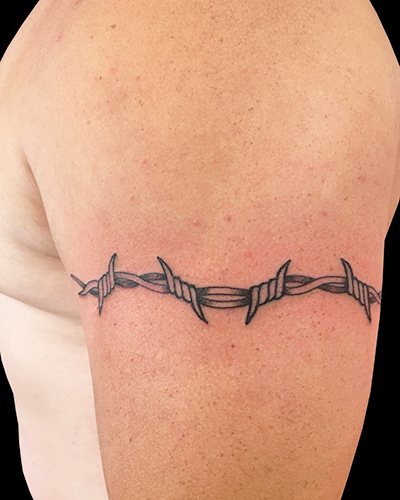

- If the pattern is wrapped around the wrist. with various hearts and ovals, it suggests that the bearer of the tattoo had a very great love in this life. If there are blood drops added to the design, it indicates that the love passed with very negative memories. A girl who got a tattoo with a barb on this spot can use it as a regular piece of jewelry.
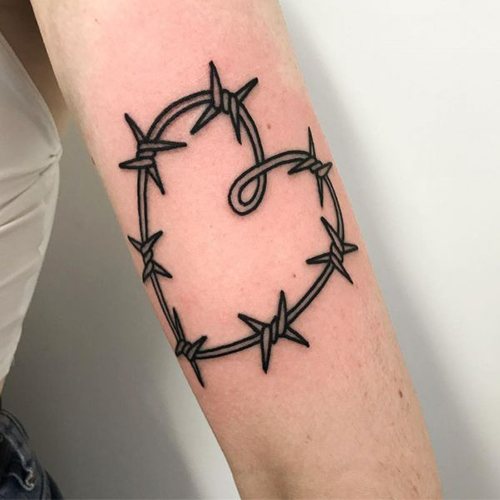

- Thigh. In this place, as a rule, such a tattoo is done only by girls. There is no special sense in it, many of the fair sex say that it just emphasizes their femininity.
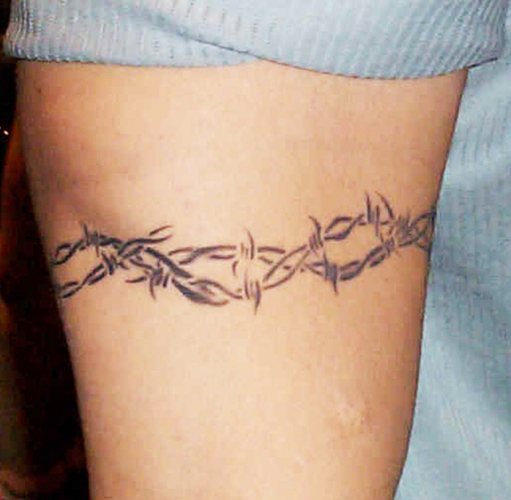

- Chest. In this place, the tattoo can be performed in any style and with a variety of meanings. In men on the chest tattoo with the image of barbed wire is often found in an artistic composition (for example, a skull, from the eye sockets of which comes out the barbed wire). On women's breasts, such a symbol is placed horizontally, often decorated with flowers or hearts. Men prefer the massiveness of barbed wire images.
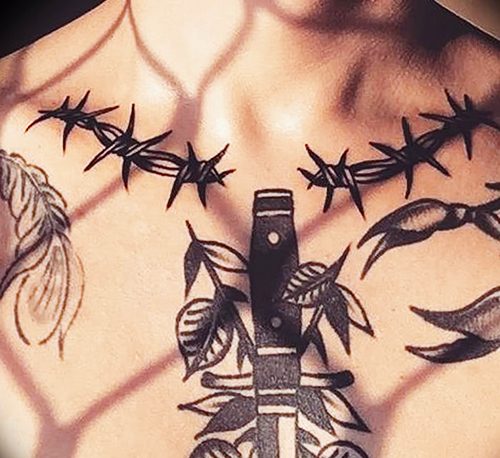

- Ankle. This area is tattooed by both guys and girls. Most often it is applied simply for decorative purposes. The wire can be supplemented with a skull (for men) or floral motifs (for women).
Meaning of the incarceration tattoo
The tattoo was widespread in prisons and prisons, the main meaning being captivity.


A symbol of the term of imprisonment, the spike equaled one year. A person possessing such a tattoo made it clear that he had a criminal record and a loyal attitude to violence. Over time, it lost its relevance.
- Sails shackled with barbed wire symbolized the long years of waiting for the freedom to which the prisoner aspired.
- On the forehead and wrists are applied to those sentenced to life imprisonment.
- The cross denotes an unjust sentence.
- Cards with a barb are worn by cheaters.
- A flaming heart wrapped in wire - compassion for one's fellow man.
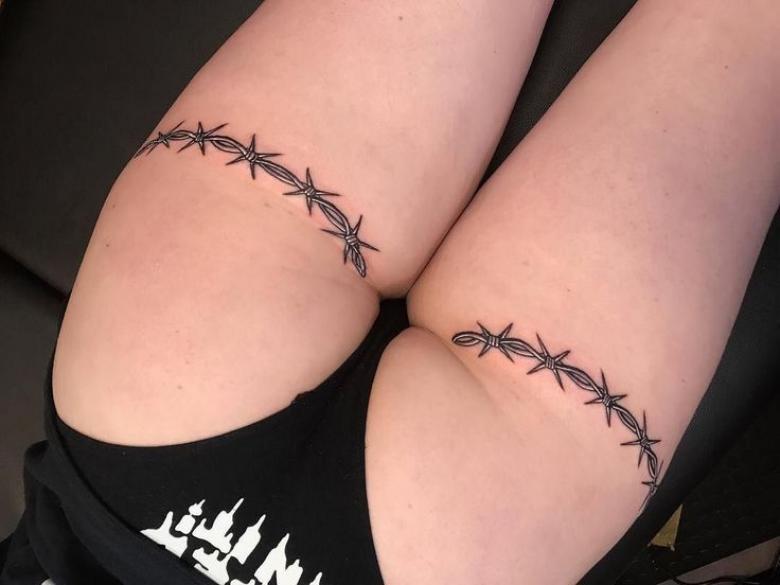

Styles and colors
The stylistic design of such a tattoo can fundamentally change its meaning, according to the masters of tattoo studios.
The most common are the following stylish compositions:
- BlackWork. This style uses monotone ink, which is basically punched along the contour of the image itself (stencil). Various colorful ornaments may also be placed in addition.
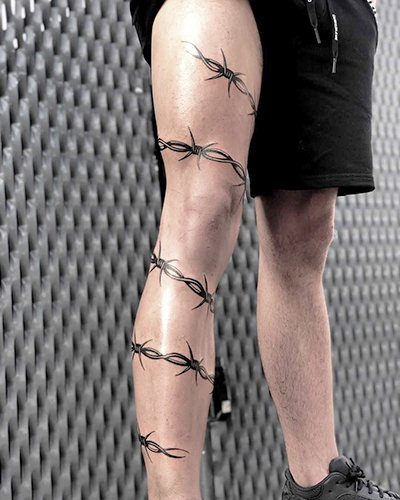

- Polka Thrash. This style is known to masters and clients because of the use of exclusively black and red ink. At the same time, the drawing on the body, as a rule, has an intimidating appearance. It can be a lot of skeletons, crosses, cemeteries. Through careful inking, the barbed wire looks only like an additional element to the main body drawing. Red ink can be inserted in such a way that it resembles the strokes of an ordinary paintbrush.
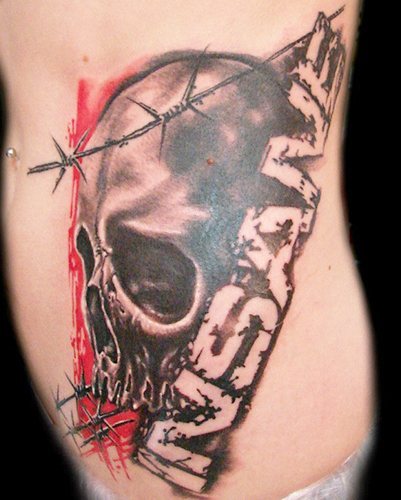

- Realism. This style is not available to all specialists of tattoo studios. The purpose of this style is an image as similar as possible to the real one (and in some cases, elements of 3D are used).
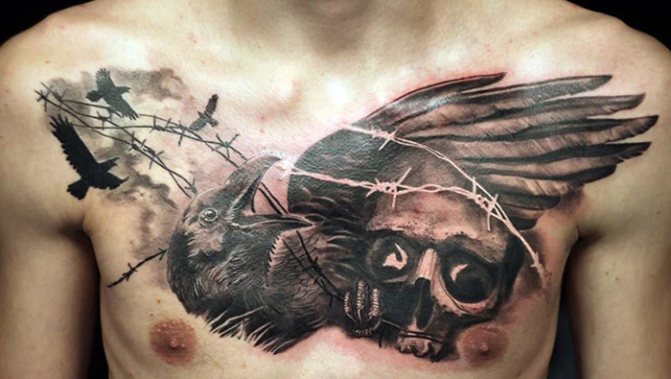

- Art Brut. This style is chosen by young girls and guys who want to stand out from the crowd as much as possible. The picture of such a plan may resemble objects, at first glance, unrelated to each other. Also, if the client wishes, the master can use quite bright and prominent paints.
- Treble. At one time, this style was one of the most popular among body art decorations. The image is applied exclusively with black paints and gives the subject a stenciled image. Today, only fans of this style get themselves similar tattoos.
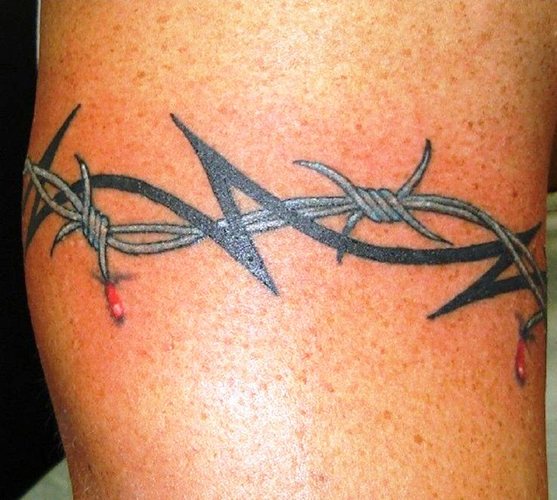

- Engraving. Refers to the image of large, sprawling images at the expense of precise and accurate drawing of the basic outline.
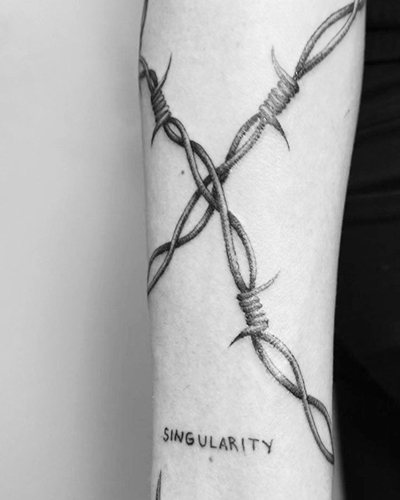

- Old School. One of the most popular styles today. Depicts uncomplicated objects and stands out, thanks to the combination of different bright colors. The barbed wire pattern will be perfect for this style of image.
The choice of a particular style and color depends only on the desire of the client himself, as well as on the capabilities of a particular specialist.
Value
Tattoos (barbed wire is a frequent theme with prisoners) can be supplemented with various items both for simple decoration and carrying a specific meaning.
Below is a table with various descriptions:
| Heart | If the wire wraps around a heart, the tattoo symbolizes a great love that has brought much sorrow. |
| Torn wire. | Signifies the end of a difficult period of life. |
| Torn by a flower or bird | Symbolizes the wearer's desire to live in peace with others. |
| A spike with a flag. | The bearer was in military service overseas. |
| Wire wrapped around a cross | Man will defend his claims to the end. |
| Wrapped barb. | Can serve as both a common decoration and a sign of imprisonment. |
The tattoo (the barbed wire can signify not only imprisonment, but also the pursuit of freedom) also Can be depicted with other religious and sensual objects.
- A heart with drops of blood. Means the loss or departure from the life of a very close and dear person.
- A rose or a butterfly Give the tattoo the designation of certain life obstacles, which must be passed to find the long-awaited peace.


- The cross denotes unwavering faith in the Lord and is a protection against future sinful falls.
Other meanings
In the prison world, the sign of the barbed wire can be quite different from the "free" works:
- A person is undeservedly convicted and imprisoned. In such a case, the tattoo is depicted along with a cross, which symbolizes freedom and justice.
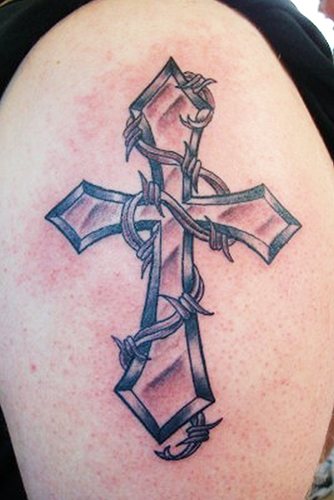

Barbed wire tattoo with a cross
- The wire is portrayed together with a sailboat in the case, if in front of the person waiting for many years of imprisonment, but despite this, he does not lose hope for a happy future.
- In women's prisons, the barbed wire is depicted together with a rose, which indicates that the girl spent her adulthood in prison.
- The number of thorns tattooed often indicates years spent in captivity.
- In rare cases, tattoos are placed on the forehead or wrists, symbolizing the award of a life sentence.
For women.
The presence of a tattoo with barbed wire in girls indicates that the wearer loves freedom and entertainment, at the same time hating various prohibitions and restrictions. Such tattoos, as a rule, are applied to their bodies by confident and determined girls.
Rose, entwined with a wire, can symbolize the innocence and unapproachability of women. Making such a tattoo, its owner speaks not only about mental but also bodily purity. There is also another meaning - the girl is looking for a life partner, with whom she wants to spend the rest of her life.
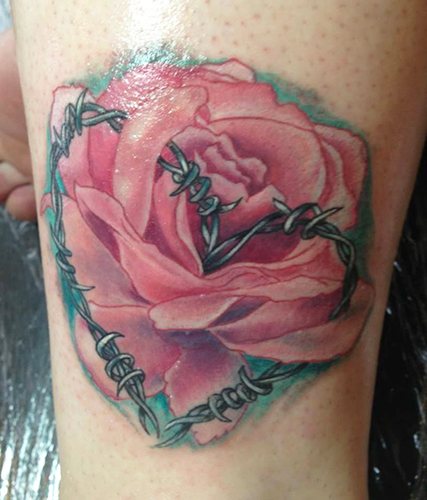

A bird next to a thorn means the fulfillment of the desires of its bearer. With this sign, she depicts various obstacles that need to be passed in order to be happy. Often in such a tattoo, the bird's paws hold a wire.
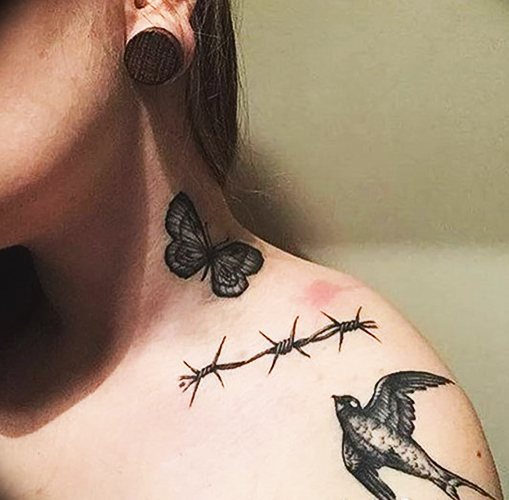

The thorn bracelet on a woman's wrist symbolizes protection from various kinds of trouble, enemies and aggression, of which there is enough in the world.
On the waist, as a rule, such a tattoo is worn by girls engaged in the most ancient profession.
For men
Tattoo (barbed wire can indicate independence and loneliness) in men lets others know that they are completely independent individuals. As a rule, such men know the value of freedom, value it, and also have an individuality.
If there are flowers next to the wire, it means a sensitive male nature. As a rule, by such a symbol the young man wishes to show that his outward behavior is not comparable with the inner world. The harsh reality forces such men to be harsh and cold. To know the real character of such a guy is possible only in the case of close acquaintance with him.
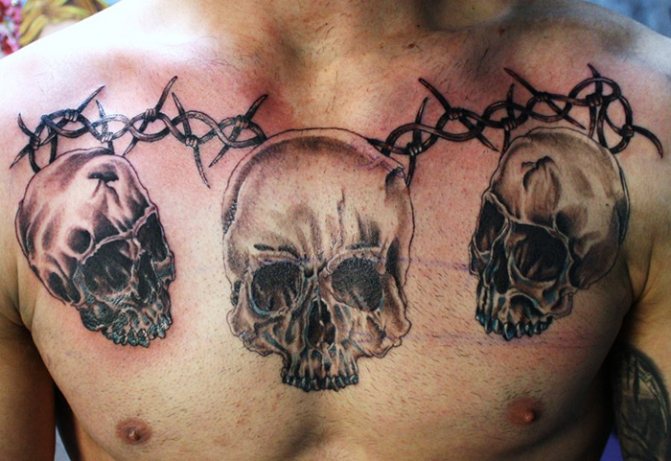

If the man's chest depicts a skull with barbed wire, it shows that he suffered the loss of a very dear person. Quite often such a tattoo is complemented by initials or the full name of the lost person.
Meanings of the barbed wire tattoo
This image appeared several decades ago, its original meaning - "boundary of freedom", "flesh tearing". It was often used by underground anarchist organizations, as well as in places of detention.
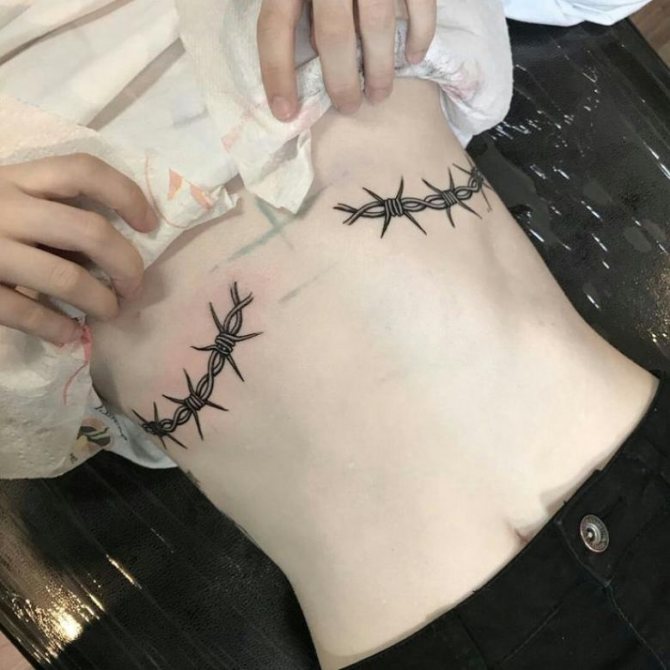

Quite widespread recognition of this type of tattoo has gained in connection with the emergence of new musical trends.
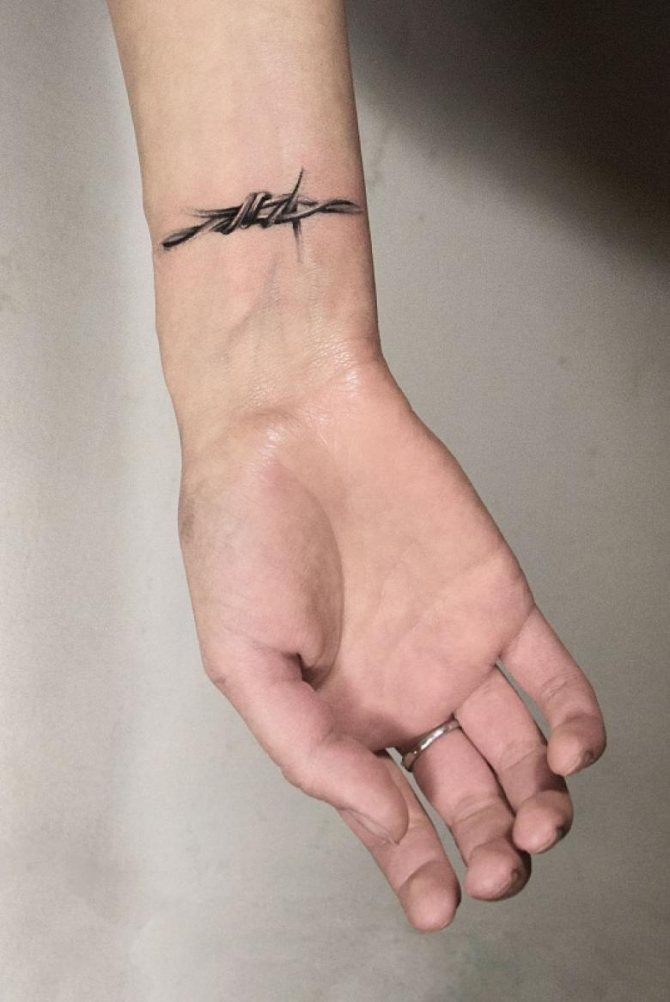

The main classic meanings are:
- willfulness;
- love of freedom;
- desire for independence;
- sacrifice;
- struggle;
- mercy;
- the destruction of the old order.


Often, the image is accompanied by a kind of addition that carries a hidden meaning, but here it is important to understand that the place where it is applied may also contain a hidden message:
- the center of a flaming or bleeding heart speaks of the loss of a loved one, may include a name;
- angel with a crown of barbed wire symbolizes deep repentance for wrongdoing;
- a wrapped cross is an image of faith in God, a rose in this case denotes obstacles;
- the crown of thorns is a sign of readiness for redemption.
- symbolism of the state under the barbed wire one of the types of tattoos popular with the military, means patriotism and devotion to their country;
- tears in the wire - the end of certain stages of life, in the case where there is an image of a dove or butterfly direct denial of war, the desire for peace;
- intertwined hearts - love accompanied by trials, hardships.


Techniques for application, painful sensations
Tattoo (barbed wire can be supplemented with other elements) always begins with a choice of the sketch you like. Today, masters of tattoo studios have such extensive experience in drawing on the body that you can choose any style you like: a realistic picture, a pattern, Celtic symbols. Below are the main factors that are important for proper tattooing.
Starting the way to the tattoo salon, a person should know at least approximately what he or she really wants. It is necessary to pick up several sketches that one likes, among which the master will be able to choose the most suitable variant for the client. It is possible to combine two sketches into one. This is often used by creative people who want to create a unique, inimitable drawing.
If the choice falls on the Celtic patterns or other religious symbols, you should familiarize yourself with the meanings of these drawings, as well as read their history.
It is necessary to choose the right place for the drawing. Not all designs are suitable for a particular part of the body. For example, a picture tattooed on the back with 99% probability will not look at all on the shoulder. The easiest way to stuff pictures on the buttocks, abdomen, forearm, wrist, because these places are quite far from bones and nerve endings. Another important point - the quality of the applied tattoo depends entirely on the type and color of the skin, as well as its hue.
When choosing a small size tattoo, you need to choose a concise and simple pattern, or design. Large tattoo requires special attention and requirements to create a sketch, because it is done for life.
Process of infliction
First of all, the picture selected by the client is printed on a printer on special, transfer paper. Next, the master carefully cuts the picture along the contour. It is possible to notch the sketch on the edges. It is necessary for the picture to lie tightly on the body.
The client's skin is shaved before the session on its own. If a person for some reason could not shave an area of the body, the master uses a disposable loom to clean the hair. After shaving, the area where the tattoo will be located is treated with an antiseptic agent.
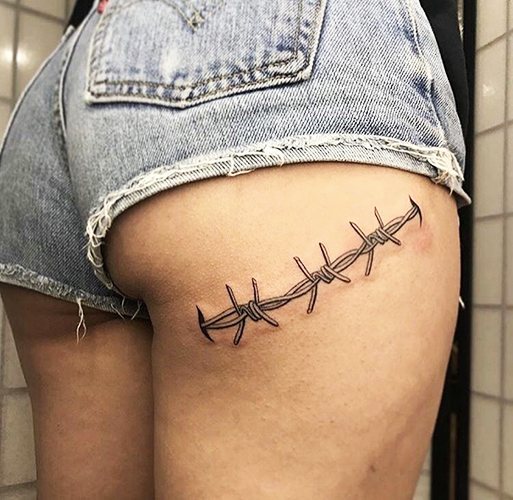

After that, the specialist applies a special compound to the client's skin, which is necessary for the image to be transferred clearly.
The sketch is attached to the skin and strongly pressed by the master. After 1-2 minutes, the paper is gently removed from the body and the outline of the sketch remains on the skin. If the contours are not partially on the skin, the master can use a special marker, which can finish drawing the necessary elements. Experienced specialists can do it by eye, from memory. Beginners look at the full picture and from it draw the contours.
After the above, the drawing itself is applied. For less sensitivity, the client's skin can be lubricated with petroleum jelly, but this is not mandatory. After that, the needle of the tattoo machine is lowered into the ink and the master begins to beat out the contours. Excess paint on the skin is brushed off with a pre-prepared cloth or cotton swab.
After the contours are clearly marked, the expert takes the painting machine in his hands and fills the picture with colors. First of all, the dark colors of the image are drawn, after them - the colored colors.
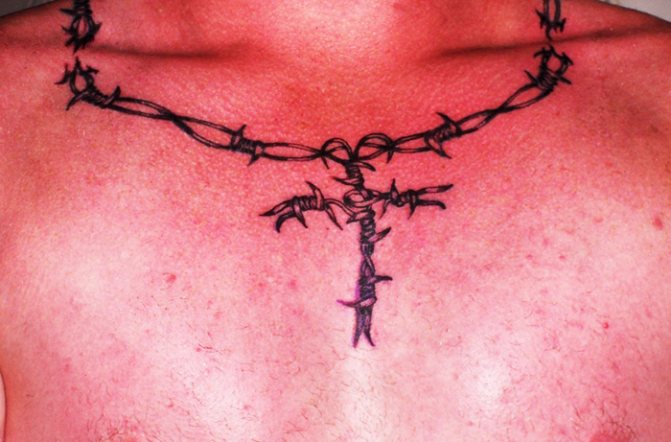

The above steps depend on the skin and body of the client.
After applying the last stroke, the master removes the remaining drops of paint from the body. The client can come up to the mirror and evaluate the specialist's work. After the assessment, the master applies special ointments that can quickly restore the skin, as well as anti-infection agents. The newly made tattoo is tied with a simple transparent film or a child's diaper (it absorbs moisture and excess paint well).
You can use an ordinary plaster to fix the film. After that, the client must strictly follow the rules of care for the affected area of the body, because the "future" of the made picture depends on it.
It is worth noting that one of the main factors of a successful tattoo depends directly on the selected master. Before you choose a specialist, it is necessary to get acquainted with his portfolio and look at the works made by him. This can be done both on the Internet and directly in the studio. If the master does not have examples of his work - you should immediately leave the salon, because the "novice" specialists can not only spoil the body, but also bring an infection into the body.
Pyramidal barrier
Pyramidal barriers are marked with indication of fence type, trademark, number of spirals and their diameters in transport position, as well as the number of staples installed per pair of spiral turns. When stretching the pyramidal barrier to the recommended length, the diameters of spirals are reduced by 10-12%, respectively, the height of the pyramidal barrier is also reduced. Stretching the pyramidal barrier beyond the recommended length is highly discouraged.
Labelling of pyramidal barriers
| Name | Brand name | Number of spiral barriers, pcs. | Diameter of spiral, mm | Diameter of stretched spiral, mm | Number of staples on a pair of coils, pcs. | Height of pyramidal barrier, mm |
| ZKR-PM "Kaiman-2х800/5+950/7 | Cayman | 2+1 | 800, 950 | 700-720, 830-850 | 5, 7 | 1350-1450 |
| ZKR-PM "Kaiman-6x1100/7" | Cayman | 6 | 1100 | 970-1000 | 7 | 2550-2700 |
ZKR-PM
- Barbed-cutting pyramidal barrier
Cayman
- trademark
800
- bottom spiral diameter
5
- number of staples on a pair of coils of lower spirals
950
- top coil diameter
7
- Number of staples per pair of upper coil turns
Can I Make It Myself
Having decided to save money on a good master and studio, a tattoo can be done by yourself. You can, but you don't have to. First, there is a risk of infection entering the body, because a person may not feel the needle going quite deep under the skin on their body. Secondly, it is not comfortable.
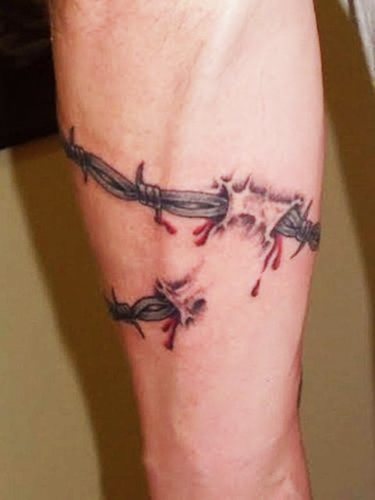

The option of self-tattooing is only on the other arm. That is, if a person is right-handed, he is able to do a more or less suitable drawing on the left hand. However, you should not do this, because the person from the outside (the master) is much better able to see the flaws and every point of the drawing.
Double Spiral Grappling
Double spiral barrier The double helix barrier is marked with the indication of the barrier type, trademark, diameter of the inner helix and diameter of the outer helix in the transport position. When stretched to the recommended length, the spiral diameters are reduced by 10-12%. Stretching the double helix barrier beyond the recommended length is highly discouraged.
Marking of double spiral barriers
| Name | Brand | Diameter of outer helix, mm | Diameter of stretched outer spiral, mm | Diameter of inner helix, mm | The diameter of the stretched inner helix, mm |
| ZKR-DS "Cobra-800 + 500 | Cobra | 800 | 700-720 | 500 | 440-450 |
ZKR-DS
- Double spiral barbed-cutting fence
Cobra
- brand name
800
- outer spiral diameter
500
- diameter of inner spiral
Tattoo care
In tattoo studios, which have a great popularity and rating, the masters after the session tighten the applied drawing not with a simple film or diaper, but with a material with a special coating, which does not allow dirt to penetrate into the affected area, and also protects the skin from external negative factors, while allowing it to breathe freely.
Basic care:
- After 6-10 hours (depends on the tattoo, more details will tell the master) the film can be removed from the body.
- The place should be washed with water, preferably with liquid soap. Strong pressure on the skin is not necessary.
- After that, the skin is wiped with a cotton swab and should then be completely dry.
- The client should then lubricate the affected area with a healing ointment (e.g. Panthenol) and wrap the skin again with cling film.
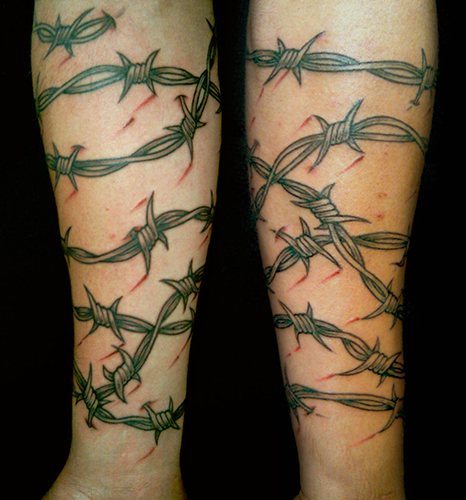

The procedure should be repeated 3-4 times a day until healing is complete. The barbed wire tattoo also requires constant care and monitoring, so you need to follow the above recommendations.
Tips for sketches
Barbed wire refers to specific images. In order for the barbed wire drawing to be decorative in nature, it is recommended to avoid cheap dyes.
It is better to make a sketch of the tattoo on the basis of photos of real products. This will help the master to arrange the accents of light and shades.
The images are performed in the styles:
- chicano;
- realism;
- black and white;
- tribal;
- traditional;
- old skool;
- blackwork.
Drawings can be in black and white or in color. The choice depends on the owner's preferences.
For the result to fully meet expectations, experienced craftsmen advise not to take ready-made drawings. It is better to make a sketch under the owner, then it will be the most suitable for the wearer.
Recommended to read: The points of the tattoo


